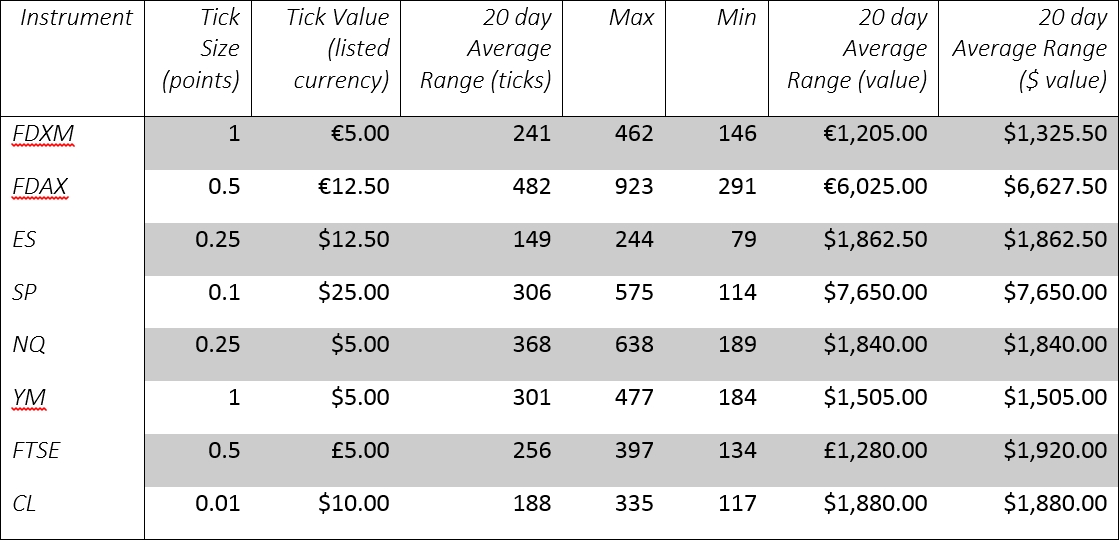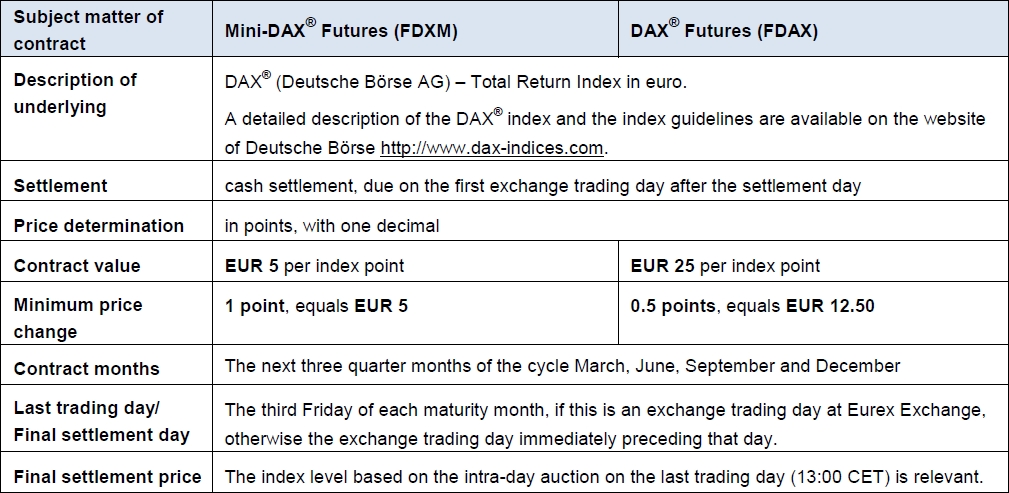You heard right. Eurex have recently announced an additional product to their already popular futures lineup – the Mini DAX Futures.
A derivatives exchange releasing a new futures product of such potential is certainly not a frequent occurrence and anything as potentially fantastic as the Mini DAX Futures is exceptionally noteworthy. You see, the full DAX Futures is a product that many traders covet for its fluidity of movement and good liquidity, but it’s a tad expensive to trade.
According to Eurex, the new Mini DAX Futures will be available from 28 October 2015.
The Contract Specs
So let’s take a look at what the finalized specifications for the new contract are.
Trading hours (CET):-
As you can see, the new Mini DAX Futures contract is pretty much identical to the full DAX Futures, with the exception of the tick size being 1 point instead of 0.5 point and the tick value being €5 instead of €25.
With respect to round trip cost, I haven’t heard what it’ll be yet, but as soon as I know I’ll update this post.
How Did Eurex Decide on These Specs?
Well, I’m not going to try to second guess how precisely they came up with the contract specs for the new Mini DAX Futures as I’m sure it was a long process. I do know that there was a consultation and that these specs were supported for the most part. From where I’m sitting though, there are two major aspects that must have been part of their thinking.
The first aspect is how it will behave. A balance of fluidity and speed of movement, the size of the contract, its quote depth and its liquidity all contribute to the “feel” of the product. At one end of Eurex you have thin and expensive, i.e. the DAX and at the other you have thick and cheap, i.e. the Schatz.
Changing the feel completely of what is already a successful product brings a degree of risk as to how it would be received by existing participants. But there’s also the opportunity to tweak the product. Doubling the tick increment and reducing the tick size by 80% is likely to bring in more liquidity and make it seem a little slower, whilst not deviating too dramatically from the full contract.
The other aspect which Eurex will have looked at is how it would be placed relative to other popular markets. Below is a rough comparison of some popular markets based on each market’s 20 day average full session ranges.
 *Rough FX rates as of Oct 2015 – EURUSD @1.1, GBPUSD @1.5
*Rough FX rates as of Oct 2015 – EURUSD @1.1, GBPUSD @1.5
**FDXM values are theoretical based on FDAX values
Clearly the big DAX is the most expensive popular product on the list (barring the big S&P which is there for a later comparison). By contrast, the Mini DAX Futures would be the cheapest of the lot. It should be noted that there are a good number of US participants who trade the DAX and at the current EURUSD rate, it’s pretty cheap in USD. However, there’s plenty of room for it to the upside if the Euro appreciates, without starting to price out US traders.
So it seems like Eurex have gone for a good balance with the specs they’ve chosen for the new product.
Who Will Benefit?
Again, the full DAX Futures is a great product. It moves with a beautiful fluidity and yet has a degree of respect for technicals. Many traders would love to trade it.
Unfortunately for many smaller traders, the fact that the DAX is such an expensive product with large daily ranges and a high tick value, makes it prohibitive for them to trade. A 300 point daily range (which isn’t uncommon) weighs in at €7,500 per contract.
Then you’ve got to consider margin as a factor. Right now (Oct 2015) exchange margin is over €20k per contract. Day trading margin does vary and some will let you trade it for as little as $2,500 per contract but others range between 25-50% of initial margin. There’s a good chance that the Mini DAX will fall into the $500 day trading margin category.
![]() *Source – www.futuresonline.com (aka OEC)
*Source – www.futuresonline.com (aka OEC)
The only half-acceptable option for a smaller trader (if you don’t live in the US) would be to trade a CFD (Contract For Difference). But then this is not direct market access, it’s not traded on a centralized exchange and many brokers don’t even offer the future as a CFD (instead they offer a CFD on the index – meaning different prices to the futures market).
Traders who have a big enough account and/or are already trading the full DAX would benefit from the Mini DAX by being able to manage their risk with a greater degree of flexibility. A 5 lot in the full DAX doesn’t give you many scale-outs compared to the equivalent 25 lot position size in the Mini DAX.
So a mini version of the futures contract listed side-by-side with the full product is bound to be interesting to many traders.
Of course, if you’re a fund and need to hedge cash positions, it’s going to be rather more difficult to do so with the full product that has a notional value of around €250,000 per contract (€25 x index price). And this is only likely to go higher. So it’d be easy to see that an ETF might have been a better way to go prior to the introduction of the Mini DAX.
Will the Mini DAX Stick?
There are a couple of examples of new product listings that spring to mind. The first is the E-mini S&P500 Futures. Originally there was only what’s now known as the “big S&P” and it traded in tenths of a point and was $50/tick (although now it’s $25/tick)!! At the back end of the 90’s the CME decided to release the E-mini version – the ES.
People thought the ES was a joke. But just look at it today – it’s one of the most popular and heavily traded futures products in the world. Taking a look back at the comparison table, you can see just how much more expensive the full SP is versus the ES.
On the flip side, there was USFE (a now defunct exchange which started as a Eurex-MF Global joint venture) product listed back in ’08. This was in fact a mini-sized U.S. dollar-denominated DAX. It struggled from the start though with confusion over the pricing and it probably didn’t help matters that later MF Global went belly up.
But this time, the Mini DAX Futures is Eurex’s baby and I think there’s a very good chance that it’ll be a great success.
Don’t go Gung Ho
Finally I’d reiterate that this is a new product and there’s no need to go mad with it straight away. You are responsible for your own trading account.
It’s going to have designated market makers in it to provide liquidity and stability. But you just never know with a new listing. There might be no takers initially. There could be a glitch in the system. The fact that markets have been swinging about recently also adds some risk. What would happen if we got a massive sell-off in equities in the first week or so?
You just never know. This is Eurex though. The quality and experience of the exchange should mean things work out (although the tinkering they did with the Bobl tick size a few years back wasn’t the best).
Ultimately I feel that this could be an incredible product to trade and I will initially be watching it with great interest. Let’s see what it brings…




This is very exciting. I’ve wanted to trade the DAX for years – superb volatility, smooth moves and European hours. However, its always been far too lumpy to trade in the size required for effectively scale outs. I’ll be watching this very closely. Thanks for letting me know!
Could be very interesting indeed Robert!